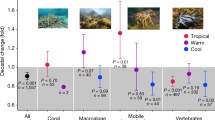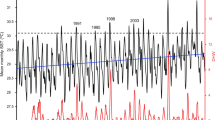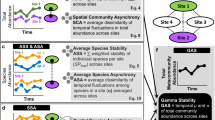Abstract
The effects of climate-driven ocean change on reef habitat-forming species are diverse1,2 and can be deleterious to the structure and functioning of seafloor communities3,4,5. Although responses of shallow coral- or seaweed-based reef communities to environmental changes are a focus of ecological research in the coastal zone1,4,5,6, the ecology of habitat-forming organisms on deeper mesophotic reefs remains poorly known. These reefs are typically highly biodiverse7,8 and productive as a result of massive nutrient recycling9. Based on seafloor imagery obtained from an autonomous underwater vehicle8, we related change in community composition on deep reefs (30–90 m) across a latitudinal gradient (25–45° S) in southeastern Australia to high-resolution environmental and oceanographic data, and predicted future changes using downscaled climate change projections for the 2060s10,11,12. This region is recognized as a global hotspot for ocean warming13. The models show an overall tropicalization trend in these deep temperate reef communities, but different functional groups associate differentially to environmental drivers and display a diversity of responses to projected ocean change. We predict the emergence of novel deep-reef assemblages by the 2060s that have no counterpart on reefs today, which is likely to underpin shifts in biodiversity and ecosystem functioning.
This is a preview of subscription content, access via your institution
Access options
Access Nature and 54 other Nature Portfolio journals
Get Nature+, our best-value online-access subscription
$29.99 / 30 days
cancel any time
Subscribe to this journal
Receive 12 print issues and online access
$209.00 per year
only $17.42 per issue
Buy this article
- Purchase on Springer Link
- Instant access to full article PDF
Prices may be subject to local taxes which are calculated during checkout




Similar content being viewed by others
Data availability
The ecological dataset derived from AUV imagery is extensively described7. All environmental datasets are available from public sources as referenced. Estimates of ecological and environmental variables associated with each transect, and which were used to fit the random forest models, are provided as online supplementary material. All the data that support the findings of this study, including R scripts, are available from the corresponding author upon request.
References
Hoegh-Guldberg, O. et al. Coral reefs under rapid climate change and ocean acidification. Science 318, 1737–1742 (2007).
Bridge, T. C. L. et al. Variable responses of benthic communities to anomalously warm sea temperatures on a high-latitude coral reef. PLoS ONE 9, e113079 (2014).
Bennett, S., Wernberg, T., Harvey, E. S., Santana-Garcon, J. & Saunders, B. J. Tropicals herbivores provide resilience to a climate-mediated phase shift on temperate reefs. Ecol. Lett. 18, 714–723 (2015).
Marzloff, M. P., Little, L. R. & Johnson, C. R. Building resilience against climate-driven shifts in a temperate reef system: staying away from context-dependent ecological thresholds. Ecosystems 19, 1–15 (2015).
Johnson, C. R. Climate Change cascades: shifts in oceanography, species’ ranges and subtidal marine community dynamics in eastern Tasmania. J. Exp. Mar. Biol. Ecol. 400, 17–32 (2011).
Mongin, M. et al. The exposure of the Great Barrier Reef to ocean acidification. Nat. Commun. 7, 10732 (2016).
James, L. C., Marzloff, M. P., Barrett, N., Friedman, A. & Johnson, C. R. Changes in deep reef benthic community composition across a latitudinal and environmental gradient in temperate Eastern Australia. Mar. Ecol. Prog. Ser. 565, 35–52 (2017).
Bewley, M. et al. Australian sea-floor survey data, with images and expert annotations. Sci. Data 2, 150057 (2015).
de Goeij, J. M. et al. Surviving in a marine desert: the sponge loop retains resources within coral reefs. Science 342, 108–110 (2013).
Oliver, E. C. J. & Holbrook, N. J. A statistical method for improving continental shelf and nearshore marine climate predictions. J. Atmos. Ocean. Technol. 31, 216–232 (2013).
Sun, C. et al. Marine downscaling of a future climate scenario for Australian boundary currents. J. Clim. 25, 2647–2962 (2012).
Matear, R. J., Chamberlain, M. A., Sun, C. & Feng, M. Climate change projection of the Tasman Sea from an eddy-resolving ocean model. J. Geophys. Res. Oceans 118, 2961–2976 (2013).
Hobday, A. & Pecl, G. Identification of global marine hotspots: sentinels for change and vanguards for adaptation action. Rev. Fish Biol. Fisher. 24, 415–425 (2014).
Wernberg, T. et al. An extreme climatic event alters marine ecosystem structure in a global biodiversity hotspot. Nat. Clim. Change 3, 78–82 (2013).
Wernberg, T. et al. Climate-driven regime shift of a temperate marine ecosystem. Science 353, 169–172 (2016).
Marzloff, M. P. et al. Modelling marine community responses to climate-driven species redistribution to guide monitoring and adaptive ecosystem-based management. Glob. Change Biol. 22, 2462–2474 (2016).
Ruzicka, R. & Gleason, D. F. Sponge community structure and anti-predator defenses on temperate reefs of the South Atlantic Bight. J. Exp. Mar. Bio. Ecol 380, 36–46 (2009).
Cathalot, C. et al. Cold-water coral reefs and adjacent sponge grounds: hotspots of benthic respiration and organic carbon cycling in the deep sea. Front. Mar. Sci. 2, 1–12 (2015).
Gili, J.-M. & Coma, R. Benthic suspension feeders: their paramount role in littoral marine food webs. Trends Ecol. Evol. 13, 316–321 (1998).
Bridge, T. C. L., Hughes, T. P., Guinotte, J. M. & Bongaerts, P. Call to protect all coral reefs. Nat. Clim. Change 3, 528–530 (2013).
Schlacher, T. A., Williams, A., Althaus, F. & Schlacher-Hoenlinger, M. A. High-resolution seabed imagery as a tool for biodiversity conservation planning on continental margins. Mar. Ecol. 31, 200–221 (2010).
Kahn, A. S., Yahel, G., Chu, J. W. F., Tunnicliffe, V. & Leys, S. P. Benthic grazing and carbon sequestration by deep-water glass sponge reefs. Limnol. Oceanogr. 60, 78–88 (2015).
Althaus, F. et al. A standardised vocabulary for identifying benthic biota and substrata from underwater imagery: the CATAMI classification scheme. PLoS ONE 10, e0141039 (2015).
Ridgway, K. R. Long-term trend and decadal variability of the southward penetration of the East Australian Current. Geophys. Res. Lett. 34, L13613 (2007).
Oliver, E. C. J. & Holbrook, N. J. Extending our understanding of South Pacific gyre ‘spin-up’: modeling the East Australian current in a future climate. J. Geophys. Res. Oceans 119, 2788–2805 (2014).
Sunday, J. M. et al. Thermal-safety margins and the necessity of thermoregulatory behavior across latitude and elevation. Proc. Natl Acad. Sci. USA 111, 5610–5615 (2014).
Sunday, J. M. et al. Species traits and climate velocity explain geographic range shifts in an ocean-warming hotspot. Ecol. Lett. 18, 944–953 (2015).
Stuart-Smith, R. D., Edgar, G. J., Barrett, N. S., Kininmonth, S. J. & Bates, A. E. Thermal biases and vulnerability to warming in the world’s marine fauna. Nature 528, 88–92 (2015).
Bates, A. E. et al. Resilience and signatures of tropicalization in protected reef fish communities. Nat. Clim. Change 4, 62–67 (2014).
Solan, M. et al. Extinction and ecosystem function in the marine benthos. Science 306, 1177–1180 (2004).
Lambert, G. I., Jennings, S., Kaiser, M. J., Davies, T. W. & Hiddink, J. G. Quantifying recovery rates and resilience of seabed habitats impacted by bottom fishing. J. Appl. Ecol. 51, 1326–1336 (2014).
Loarie, S. R. et al. The velocity of climate change. Nature 462, 1052–1055 (2009).
Comte, L., Murienne, J. & Grenouillet, G. Species traits and phylogenetic conservatism of climate-induced range shifts in stream fishes. Nat. Commun. 5, 5023 (2014).
Williams, J. W., Jackson, S. T. & Kutzbach, J. E. Projected distributions of novel and disappearing climates by 2100 AD. Proc. Natl Acad. Sci. USA 104, 5738–5742 (2007).
García Molinos, J. et al. Climate velocity and the future global redistribution of marine biodiversity. Nat. Clim. Change 6, 83–88 (2016).
Thresher, R. E., Guinotte, J. M., Matear, R. J. & Hobday, A. J. Options for managing impacts of climate change on a deep-sea community. Nat. Clim. Change 5, 635–639 (2015).
Williams, S. B. et al. Monitoring of benthic reference sites: using an autonomous underwater vehicle. IEEE Robot. Autom. Mag. 19, 73–84 (2012).
Kahn, A. S., Ruhl, H. A. & Smith, K. L.Jr. Temporal changes in deep-sea sponge populations are correlated to changes in surface climate and food supply. Deep Sea Res. Pt 1 70, 36–41 (2012).
Ling, S. D. et al. Stereo-imaging AUV detects trends in sea urchin abundance on deep overgrazed reefs. Limnol. Oceanogr. Methods 14, 293–304 (2016).
Bennett, S. et al. The ‘Great Southern Reef’: social, ecological and economic value of Australia’s neglected kelp forests. Mar. Freshw. Res. 67, 47–56 (2015).
Stobart, B., Mayfield, S., Mundy, C., Hobday, A. J. & Hartog, J. R. Comparison of in situ and satellite sea surface-temperature data from South Australia and Tasmania: how reliable are satellite data as a proxy for coastal temperatures in temperate southern Australia? Mar. Freshw. Res. 67, 612–625 (2016).
Oliver, E. C. J. & Holbrook, N. J. A statistical method for improving continental shelf and nearshore marine climate predictions. J. Atmos. Ocean. Technol. 31, 216–232 (2014).
Fabricius, K. E., De’ath, G., Noonan, S. & Uthicke, S. Ecological effects of ocean acidification and habitat complexity on reef-associated macroinvertebrate communities. Proc. R. Soc. B 281, 20132479 (2014).
Breiman, L. Random forests. Mach. Learn. 45, 5–32 (2001).
Rix, L. et al. Coral mucus fuels the sponge loop in warm- and cold-water coral reef ecosystems. Sci. Rep. 6, 18715 (2016).
Bradshaw, C., Collins, P. & Brand, A. R. To what extent does upright sessile epifauna affect benthic biodiversity and community composition? Mar. Biol. 143, 783–791 (2003).
Acknowledgements
M.P.M. and E.C.J.O. were supported by fellowships on an Australian Research Council Super Science project (FS110200029) granted to C.R.J., N.S.B. and N.J.H. We acknowledge IMOS for funding the AUV monitoring programme, and IMAS, DPI NSW, and the National Environmental Research Program Marine Biodiversity Hub, a collaborative partnership supported through the Australian Government’s National Environmental Science Programme, for facilitating many of the deployments. We thank S. Williams, A. Friedman and the Australian Centre for Field Robotics (University of Sydney) for their support in terms of accessing and scoring the AUV imagery. We are grateful to R. Matear and M. Chamberlain of CSIRO Marine and Atmospheric Research (Hobart, Australia) for helpful discussions and access to the OFAM model simulations (providing ocean projections for the 2060s), supported by the Western Australian Marine Science Institution Node 2 ‘Climate processes, predictability and impacts in a warming Indian Ocean’ led by M. Feng.
Author information
Authors and Affiliations
Contributions
All authors provided comments on the paper. M.P.M. led the research, performed the analyses and wrote the paper. E.C.J.O. performed the statistical downscaling of the climate projections for the 2060s. L.J. analysed the seafloor imagery and consolidated the ecological dataset. S.J.W. provided guidance about statistical modelling techniques. C.R.J., N.S.B. and N.J.H. conceived the project and provided guidance in the conduct of the research.
Corresponding author
Ethics declarations
Competing interests
The authors declare no competing interests.
Additional information
Publisher’s note: Springer Nature remains neutral with regard to jurisdictional claims in published maps and institutional affiliations.
Supplementary information
Supplementary Information
Supplementary Notes/Discussions 1–5, Supplementary Figures 1–19, Supplementary Tables 1–14, Supplementary References
Supplementary Data
Supplementary Data 1
Rights and permissions
About this article
Cite this article
Marzloff, M.P., Oliver, E.C.J., Barrett, N.S. et al. Differential vulnerability to climate change yields novel deep-reef communities. Nature Clim Change 8, 873–878 (2018). https://doi.org/10.1038/s41558-018-0278-7
Received:
Accepted:
Published:
Issue Date:
DOI: https://doi.org/10.1038/s41558-018-0278-7



